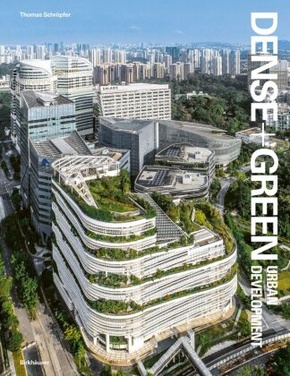Dense+Green Urban Development - Emerging Models of Integrated Architecture
| Verlag | Birkhäuser Berlin |
| Auflage | 2025 |
| Seiten | 320 |
| Format | 23,5 x 2,7 x 30,7 cm |
| Gewicht | 1800 g |
| Artikeltyp | Englisches Buch |
| ISBN-10 | 3035624550 |
| EAN | 9783035624557 |
| Bestell-Nr | 03562455A |
Das Buch dokumentiert nachhaltige integrierte Stadtteile als Modelle für Städte mit hoher Dichte und Lebensqualität. Es zeigt auf, wie grüne Elemente strategisch eingesetzt und in umfassendere systemische Lösungen auf urbaner Ebene eingebettet werden. Neben der Identifizierung von Schlüsselfaktoren für eine erfolgreiche räumliche Umsetzung werden auch die Planungsinstrumente und Governance-Regelungen untersucht, die solche Entwicklungen in unterschiedlichen sozialräumlichen Kontexten erlauben.
Die Publikation, die in Zusammenarbeit mit dem Singapore-ETH Centre, der SUTD und der ETH Zürich entstanden ist, dokumentiert internationale Fallstudien, darunter one-north in Singapur, King's Cross in London und Quayside in Toronto. Sie untersucht auch die städtische Grünentwicklung innerhalb der Bestandsstruktur Zürichs.
Eingehende Analysen internationaler Fallstudien Umfasst urbane und architektonische Entwürfe, Planungsinstrumente sowie sozialräumliche Kontexte Mit e inem Vorwort von Kees Christiaanse
Building on previous Dense+Green publications, this book explores sustainable integrated districts as models for high-density, high-liveability cities. It highlights how green elements are strategically deployed and integrated into broader systemic solutions at an urban scale. Beyond identifying key factors for successful spatial implementation, the book examines the planning instruments and governance arrangements enabling such developments across diverse socio-spatial contexts.
A collaboration between the Singapore-ETH Centre, SUTD, and ETH Zurich, the publication provides in-depth analyses of international case studies, including one-north in Singapore, King's Cross in London, and Quayside in Toronto. It also explores urban green development within Zurich's existing fabric.
In-depth analysis of international case studies Integrating urban and architectural design, planning tools, and socio-spatial contexts With a foreword by Kees Christiaanse

